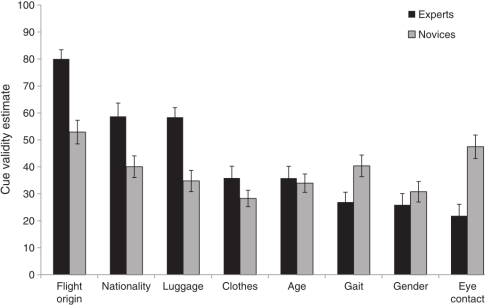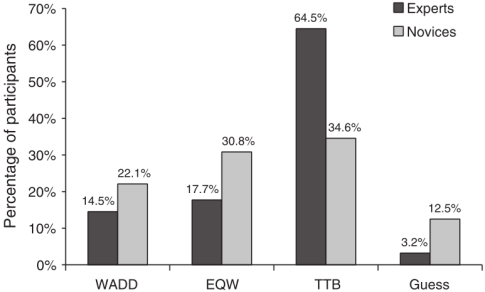Heuristics for dodging Swiss customs
CUES CUSTOMS OFFICERS USE
When leaving an international airport, you usually see many people walking straight through customs, but occasionally see a passenger whose suitcases are being searched by customs officers. How do the customs officers decide which people to stop? It must be a case of cue-based inference. This leads to two natural questions. What are the cues? How are they used?
By interviewing the chief customs officer at a major international airport, Thorsten Pachur and Gianmarco Marinello found out what the common cues are in a paper called Expert intuitions: How to model the decision strategies of airport customs officers?:
- flight origin
- gender
- nationality
- age
- amount of luggage
- eye contact with officer
- clothing
- speed of gait
Which cue values point in which direction? For smuggling drugs, the relationships go like this (positive values are more indicative of a drug smuggler).
Customs officers have beliefs about the predictiveness of these cues. The bar graph at the top shows how diagnostic officers felt each cue to be (on a scale where 1=not diagnostic and 100=highly diagnostic). As you can see experts and novices have different opinions about the validities of cues (e.g., experts know that eye contact tells you nothing, which is good news for me since I rarely make it, like, ever).
Now, you’re a customs officer. Here’s your task:
On analyzing many such decisions made by actual customs officers, Pachur and Marinello can predict which strategy people are using to decide:
- WADD – Weighted additive (combine everything after giving each cue a weight)
- EQW – Equal weight (combine everything but give every cue equal weight)
- TTB – Take The Best (use Gigerenzer and Goldstein’s 1996 Take-The-Best heuristic)
- Guess – Guess
As in many such studies, those who have done the task a lot (experts) drop into a lexicographic TTB strategy:
CITATION
Pachur, T., & Marinello, G. (2013). Expert intuitions: How to model the decision strategies of airport customs officers?. Acta Psychologica, 144, 97-103. doi:10.1016/j.actpsy.2013.05.003
ABSTRACT
How does expertise impact the selection of decision strategies? We asked airport customs officers and a novice control group to decide which passengers (describedon several cue dimensions) they would submit to a search. Additionally, participants estimated the validities of the different cues. Then we modeled the decisions using compensatory strategies, which integrate many cues, and a noncompensatory heuristic, which relies on one-reason decision making. The majority of the customs officers were best described by the noncompensatory heuristic, whereas the majority of the novices were best described by a compensatory strategy. We also found that the experts’ subjective cue validity estimates showed a higher dispersion across the cues and that differences in cue dispersion partially mediated differences in strategy use between experts and novices. Our results suggest that experts often rely on one-reason decision making and that expert–novice differences in strategy selection may reflect a response to the internal representation of the environment.






The customs need to design a good strategies to combat the smuggler.
June 25, 2013 @ 11:50 am